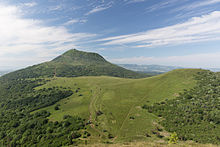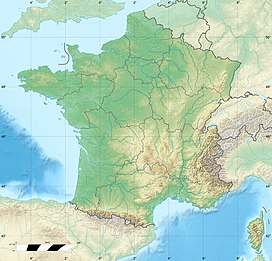Puy de Dôme
This article includes a list of general references, but it lacks sufficient corresponding inline citations. (April 2009) |
| Puy de Dôme | |
|---|---|
 General view | |
| Highest point | |
| Elevation | 1,465 m (4,806 ft)[1] |
| Prominence | 485 m (1,591 ft) |
| Isolation | 18.41 km (11.44 mi) |
| Coordinates | 45°46′19″N 02°57′45″E / 45.77194°N 2.96250°E |
| Geography | |
| Location | Puy-de-Dôme, Auvergne, France |
| Parent range | Chaîne des Puys region of Massif Central |
| Geology | |
| Mountain type | Lava dome |
| Last eruption | c. 10,700 years ago[2] |
| Climbing | |
| First ascent | Unknown |
| Easiest route | road |
Puy de Dôme (US: /ˌpwiː də ˈdoʊm/,[3] French: [pɥi də dom] )[4] is a lava dome and one of the youngest volcanoes in the Chaîne des Puys region of Massif Central in central France. This chain of volcanoes including numerous cinder cones, lava domes and maars is far from the edge of any tectonic plate.[5] Puy de Dôme was created by a Peléan eruption, some 10,700 years ago. It is approximately 10 km (6 miles) from Clermont-Ferrand. The Puy-de-Dôme département is named after the volcano.
History
[edit]
In pre-Christian Europe, Puy de Dôme was an assembly place for spiritual ceremonies.[6] Temples were built at the summit, including a Gallo-Roman temple of Mercury, the ruins of which were discovered in 1872.[7]
In 1648, Florin Périer, at the urging of Blaise Pascal, supported Evangelista Torricelli's theory that barometric observations were caused by the weight of air by measuring the height of a column of mercury at three elevations on Puy de Dôme.[8]
In 1875, a physics laboratory was built at the summit. Since 1956, a TDF (Télédiffusion de France) antenna is also located there. On the top of the mountain, there is a transmitter for FM radio and TV.
Tourism
[edit]
A UNESCO World Heritage site since 2018,[9] the Puy de Dôme is one of the most visited sites in the Auvergne region, attracting nearly 500,000 visitors a year. The summit offers expansive views of the Chaîne des Puys and Clermont-Ferrand. It is a well-known centre for paragliding.
The summit can be reached by two pedestrian paths. The southern one, "Le sentier des muletiers" ("The Mule Trail"), was formerly a Roman road. The northern one, "Le sentier des chèvres" ("The Goat Trail"), runs past the Nid de la Poule (Hen's Nest} crater. The GR 4 long-distance trail includes both paths to cross the mountain.
Since May 2012, visitors can also go up the mountain by train with the Panoramique des Dômes, a rack railway.
A road exists along the railway but it is closed to general traffic, except for the military, service vehicles or emergencies.
At the top of the mountain, restaurants and shops are available as well as a visitor centre giving information on the history and geology of the area.
Geological heritage site
[edit]In respect of its key role in the development of volcanology as a geoscience discipline, the Puy-de-Dôme and Petite-Puy-de-Dôme volcanoes were included by the International Union of Geological Sciences (IUGS) in its assemblage of 100 "geological heritage sites" around the world in a listing published in October 2022.[10]
Sport
[edit]Cycling
[edit]In more recent times, Puy de Dôme has served as an occasional stage finish in the Tour de France. It was here that in 1964 Raymond Poulidor battled with Jacques Anquetil in one of the race's most famous moments, racing side by side up almost the entire climb; and that in 1975 Eddy Merckx was punched in the kidney by a spectator.[11]
Between the 1988 and 2023 Tour de France summit finishes, only the first part of the ascent to the Col de Ceyssat was covered in the 13th stage of the 2020 Tour de France. The 2012 construction of the Puy de Dôme rack railway narrowed the already very narrow road to the top. Because of the increasing logistical demands of the Tour, many thought that the Tour would never return after 1988[12] but the 9th stage of the 2023 Tour de France had a summit finish, which was won by Michael Woods. However, spectators were not permitted on the climb.[13]

The road is open to cyclists only during very limited periods when other vehicles are prohibited. In 2006 this was 7–9am on Wednesdays and Sundays between 1 May and 30 September.[14] In 2017, it was the first checkpoint in the Transcontinental Race, a nonstop, unsupported bicycle race across Europe.[15]
Motorsports
[edit]The Circuit de Charade was a motorsport street circuit built in 1957 using pre-existing roads around the base of the Puy de Dôme.[16] The venue hosted the French Grand Prix as well as the French motorcycle Grand Prix several times in the 1960s and early 1970s.[16] In 1986, the track was shortened due to safety issues and was converted into a dedicated motorsport race track hosting track days, driving schools as well as historic motorsport events.[16][17]
Climate
[edit]While the lower areas of the mountain are firmly oceanic (Köppen: Cfb), Puy de Dôme has a humid continental (Köppen: Dfb) with borderline subalpine characteristics, thanks to its high elevation. Its classification is determined from its January average being well below the −3 °C (27 °F) threshold (with −5 °C (23 °F) as its usual lows), and from having over four months of average temperatures that exceed 10 °C (50 °F). (The requirement for this climate category is to have at least three such months.)
| Climate data for Puy de Dôme (1981–2010 normals; extremes 1973–2017) | |||||||||||||
|---|---|---|---|---|---|---|---|---|---|---|---|---|---|
| Month | Jan | Feb | Mar | Apr | May | Jun | Jul | Aug | Sep | Oct | Nov | Dec | Year |
| Record high °C (°F) | 14.0 (57.2) |
12.8 (55.0) |
18.0 (64.4) |
20.8 (69.4) |
22.7 (72.9) |
28.4 (83.1) |
26.8 (80.2) |
28.3 (82.9) |
24.4 (75.9) |
21.3 (70.3) |
17.1 (62.8) |
17.0 (62.6) |
28.3 (82.9) |
| Mean daily maximum °C (°F) | −0.5 (31.1) |
0.1 (32.2) |
3.6 (38.5) |
7.8 (46.0) |
9.8 (49.6) |
13.6 (56.5) |
16.7 (62.1) |
16.8 (62.2) |
12.8 (55.0) |
9.3 (48.7) |
5.1 (41.2) |
0.5 (32.9) |
8.2 (46.8) |
| Daily mean °C (°F) | −2.9 (26.8) |
−2.6 (27.3) |
0.9 (33.6) |
4.5 (40.1) |
6.9 (44.4) |
10.3 (50.5) |
13.2 (55.8) |
13.5 (56.3) |
10.1 (50.2) |
6.3 (43.3) |
2.7 (36.9) |
−2.2 (28.0) |
4.7 (40.5) |
| Mean daily minimum °C (°F) | −5.4 (22.3) |
−5.2 (22.6) |
−1.8 (28.8) |
1.2 (34.2) |
3.9 (39.0) |
7.0 (44.6) |
9.7 (49.5) |
10.2 (50.4) |
7.5 (45.5) |
3.3 (37.9) |
0.3 (32.5) |
−4.8 (23.4) |
2.3 (36.1) |
| Record low °C (°F) | −16.5 (2.3) |
−19.0 (−2.2) |
−14.2 (6.4) |
−10.0 (14.0) |
−9.0 (15.8) |
−3.0 (26.6) |
1.0 (33.8) |
2.0 (35.6) |
−2.0 (28.4) |
−7.0 (19.4) |
−12.0 (10.4) |
−16.8 (1.8) |
−19.0 (−2.2) |
| Average precipitation mm (inches) | 51.5 (2.03) |
41.3 (1.63) |
29.4 (1.16) |
30.9 (1.22) |
65.0 (2.56) |
75.6 (2.98) |
67.9 (2.67) |
53.8 (2.12) |
62.9 (2.48) |
40.9 (1.61) |
43.2 (1.70) |
53.5 (2.11) |
610.0 (24.02) |
| Average precipitation days | 11.5 | 8.5 | 9.2 | 6.0 | 10.3 | 9.6 | 10.3 | 9.4 | 9.0 | 10.3 | 10.3 | 16.0 | 120.4 |
| Source 1: Météo Climat [18] | |||||||||||||
| Source 2: Météo Climat [19] | |||||||||||||
References
[edit]- ^ Williams, Nicola (2010). France. Lonely Planet. p. 592. ISBN 9781742203393.
The ice-flecked summit of Puy de Dôme (1465m)
- ^ D. Miallier; Pierre Boivin; C. Deniel; A. Gourgaud; P. Lanos; M. Sforna; Thierry Pilleyre (2010). "The ultimate summit eruption of Puy de Dôme volcano (Chaine des Puys, French Massif Central) about 10,700 years ago". Comptes Rendus Geoscience. 342 (11): 847–854. Bibcode:2010CRGeo.342..847M. doi:10.1016/j.crte.2010.09.004.
- ^ "Dôme, Puy de". Merriam-Webster.com Dictionary. Merriam-Webster. Retrieved 24 August 2019.
- ^ Auvergnat: Puèi Domat [ˈpœj duˈma(t)] or Puèi de Doma [ˈpœj də ˈdumɔ]
- ^ Baier, Johannes (2021). "Das Vulkanfeld Chaîne des Puys". Aufschluss. 72 (6): 310–321.
- ^ Hubert, Henri (12 November 2013). The Greatness and Decline of the Celts. Routledge. ISBN 9781136202926.
- ^ Paillet, Jean-Louis; Tardy, Dominique (2012). "Le sanctuaire de Mercure au sommet du puy de Dôme : le cadre architectural d'un circuit processionnel". In de Cazanove, Olivier; Méniel, Patrice (eds.). Étudier les lieux de culte de Gaule romaine. Archéologie et histoire romaine (in French). Vol. 24. Montagnac: Monique Mergoil. pp. 197–207. ISBN 978-2-35518-029-3.
- ^ Ashworth, William B. (20 July 2023). "Scientist of the Day: Florin Périer". Linda Hall Library. Retrieved 26 August 2024.
- ^ "The Puy de Dôme: A Mystical Olympus in Auvergne". Visit Auvergne. Retrieved 26 August 2024.
- ^ The First 100 IUGS Geological Heritage Sites (PDF). International Union of Geological Sciences. pp. 28–29. ISBN 9781792399756. Retrieved 26 August 2024.
- ^ "Le Puy-de-Dôme dans le Tour de France". le dico du tour (in French). Retrieved 26 August 2024.
- ^ McGrath, Andy (20 June 2023). "What is the Puy de Dôme? Inside the legendary Tour de France climb". Cycling News. Retrieved 26 August 2024.
- ^ Fotheringham, William (9 July 2023). "Tour de France returns to storied climb of Le Puy de Dôme after 35 years". The Observer. ISSN 0029-7712. Retrieved 19 July 2024.
- ^ "Puy de Dôme - Clermont Ferrand". Climbbybike. Archived from the original on 4 October 2012. Retrieved 26 August 2024.
- ^ Beltchenko, Neil. "Transcontinental Race releases 2016 controls". Bikepackers Magazine. Archived from the original on 4 March 2016. Retrieved 26 August 2024.
- ^ a b c "Charade". RacingCircuits.info. Retrieved 4 April 2017.
- Moore, Jonathan (1 August 2013). "The Volcanic Rush of Clermont Ferrand". Speedhunters. Retrieved 26 August 2024. - ^ Rive, Franck. "A Brief History of Charade". The Racing Line. Archived from the original on 4 April 2017. Retrieved 26 August 2024.
- ^ "French climate normals 1981-2010". Météo Climat. Retrieved 19 September 2018.
- ^ "Weather extremes for Puy de Dôme". Météo Climat. Retrieved 19 September 2018.
Further reading
[edit]- Bacon, Ellis (2014). Mapping Le Tour. Glasgow: HarperCollins Publishers. pp. 270–271. ISBN 9780007543991. OCLC 872700415.
- Scarth, Alwyn; Tanguy, Jean-Claude (2001). Volcanoes of Europe. Oxford University Press. ISBN 0-19-521754-3.
- Global Volcanism Program: Chaîne des Puys
External links
[edit]

